The cult festivities were held at one of the most scenic spots on the island, Orongo, located on a narrow ridge between a 1,000 foot drop into the ocean on one side and a deep crater on the other side. The most sacred area at Orongo was Mata Ngarau, where priests chanted and prayed for success in the annual egg hunt.
One of the most fascinating sights at "Orongo" is the hundreds of petroglyphs carved with birdman and Makemake (god, the creator and highest spirit) images. Carved into solid basalt, they have resisted ages of harsh weather. It has been suggested that the images represent birdman competition winners. Over 480 birdman petroglyphs have been found on the island, mostly around Orongo. Petroglyphs are often hidden in the high grass. Many are eroded and indistinct or concealed in caves.
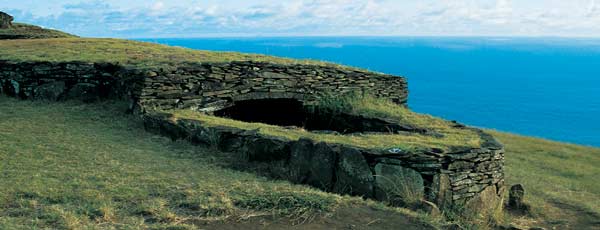
Some petroglyphs are referred to status, some to clans; others were offerings or supplications; some marked the location of special rites and ceremonies, esoteric aspects of the society. There is a connection with some petroglyphs to ancient myths as well as some that appear to be clan-related.
That culture's most famous features are its enormous stone statues called moai, over 300 of which once stood upon massive stone platforms called ahu, these are mainly near the coast. The crucial centres of ceremonial activity were the ahu, were the sanctuaries of the people of Rapa Nui, and the moai statues were the ritually charged sacred objects of those sanctuaries.These are the Ahu Moai.
The "Mana" or spiritual presence of Rapa Nui is still strongly present at the ahu sites and a top of the sacred volcanoes. The level of intellectual achievement of at least some parts of Easter Island society can be judged by the fact that a number of these ahu have sophisticated astronomical alignments, usually towards one of the solstices or the equinox. At each site they erected between one and fifteen of the huge stone statues that survive today as a unique memorial to the vanished Easter Island society. It is these statues which took up immense amounts of peasant labour. The statues were carved, using only obsidian stone tools, at the quarry at Rano Raraku volcano. They were fashioned to represent in a highly stylised form a male head and torso.
The statues were symbols of authority and power, both religious and political. But they were not only symbols. To the people who erected and used them, they were actual repositories of sacred spirit.

Ahu Semipiramidal, is a tumulus or collective funeral platform, many of them were reused in relation to funeral aims.
The Poe Poe Ahu, is the resemblance to European sea vessels know as poe poe. The two extremes of its elongated structure were raised like the bow and stern of a ship.
Ahu Tahai-Ko Te Riku, set of ceremonial altars that constitutes the most well renovated archeological site on the island. This is composed of three Ahu, the Ahu Kote Riku is the platforms on which the Moai were erected and located to the North, the eyes of the Moai are made of white coral and the pupil of obsidian.. The Ahu Tahai in the centre and the Ahu Vai Uri to the South.
Ahu Tongariki

One kilometer from Rano Raraku, had the most and tallest moai, 15 in total. This has the largest funeral platform in Rapa Nui. It is a monument to the acquired political and economic power of Hotu Iti.
Ahu O Paro
Here is the largest Moai erected on an Ahu. To one side there is a round stone, the legends said that has magical powers.
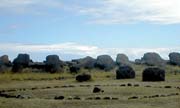
Ahu Vaihu
This is a semi destroyed temple.
Ahu Tepeu
This is also a semi destroyed temple, this is a characteristic village of boathouses destined for use by the nobles of the Miru clan.
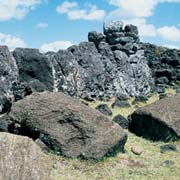
Ahu Te Pito Kura
Here is the largest Moai transported from the Rano Raraku quarry.
Ahu Akahanga
This was the burial place of King Hotu Matua. The platform is decorated with red stones and with petroglyphs, there are 13 Moai.
Ahu Huri A Urenga
There is only one Moai. The Ahu is located to astronomical guidelines related to the winter solstice. This is the only Moai with four hands.
Ahu Akivi
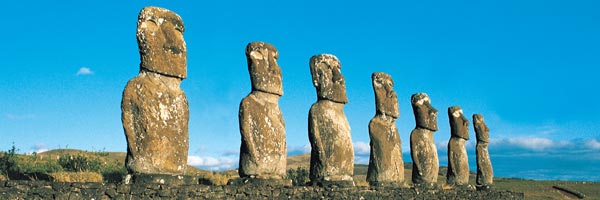
is an especially sacred place. Ahu Akivi is a sanctuary and celestial observatory built about 1500 AD which was the subject of the first serious restoration accomplished on Easter Island by archaeologists William Mulloy and Gonzalo Figueroa, with excellent results. As in the case of many religious structures on Easter Island, it has been situated with astronomical precision. Here there are seven statues look towards the point where the sun sets during the equinox.
Ahu Vinapu

In this place there are enormous stone seats. It has a superficial similarity to some Inca stone walls in South America.

Ahu Nau Nau
This is located in Anakena beach. It has seven Moai that boast details such as tattoos and clothing that are not present in other statues.
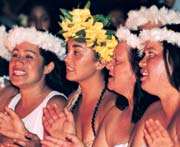
This civilisation attained a level of social complexity that gave rise to one of the most advanced cultures and technological feats of Neolithic societies anywhere in the world. Easter Island's stone working skills and proficiency were far superior to any other Polynesian culture, as was its unique writing system. This most extraordinary society developed, flourished and persisted for more than one thousand years, before it collapsed and became all but extinct.
Few centuries after the island was settled, the people of Easter Island destroyed their forest, degraded the island's topsoil, wiped out their plants and drove their animals to extinction. As a result of this self inflicted environmental devastation, its complex society collapsed, descending into civil war, cannibalism and self destruction. When Europeans discovered the island in the 18th century, they found a crashed society and a deprived population of survivors who subsisted among the ruins of a once vibrant civilisation.
Easter Island was different because the crop production took very little effort and therefore there was plenty of free time which the clan chiefs were able to direct into ceremonial activities. The result was the creation of the most advanced of all the Polynesian societies and one of the most complexes in the world for its limited resource base. The Easter Islanders engaged in elaborate rituals and monument construction. Some of the ceremonies involved recitation from the only known Polynesian form of writing called Rongorongo. One set of elaborate rituals was based on the bird cult at Orongo, where there are the remains of forty seven special houses together with numerous platforms and a series of high relief rock carvings.
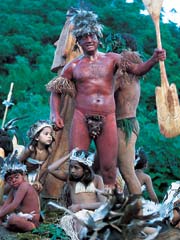
The famous Birdman Tangatamanu design can be related to cult events. The emblem of Birdman, a crouching profile human with a bird head and beak, became the symbol for the new rule by the matato'a.
The purpose of the Birdman contest was to obtain the first egg of the season from an offshore islet, Motu Nui. Contestants descended the sheer cliffs from Orongo and swam to Motu Nui where they awaited the coming of the birds. The first to procure an egg became the winner. He presented it to his sponsor who then was declared birdman for that year, an important status position.
Housing
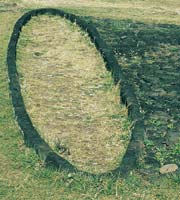
The villages and houses were made in an unusual elliptical shape. It has been speculated that this style of construction started when the new arrivals turned their boats upside down for quick housing, most of them were destroyed by the missionaries to make fences. The first islanders found a lush island, filled with giant Palms which they used to build boats and housing.
Elliptical house foundations are widespread and common, with average dimensions being 2 m. wide and 15 m. long. Low, elliptical pole and thatch houses "Hare Paenga" with dressed curbstone foundations and beach cobble pavements are associated with the elite. The largest of these structures "Hare Nui" functioned as community or specialist houses. Other house forms, include rectangular, subrectangular, oval and circular "Hare Oka". Rock shelters, caves "Ana", and refuge caves "Ana Kionga" in both coastal and inland areas commonly interpreted as temporary shelters or retreats during warfare.
Sports and Activities
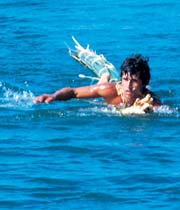
There are many sports and activities that tourists enjoy while on vacation on Easter Island.
There are many water related activities available.The Island receives pretty good surfing waves, especially during the winter months.
Fishing around Easter Island can be a unique experience, especially in the Perouge or Hanga Onu Bay (Turtles's Bay). Many of the local fishermen will take tourist with them on their fishing boast. The crystal clear waters of the Pacific Ocean and the fascinating underwater world, is good for practicing diving, the best place to practice diving is Hanga Roa Harbor, situated in the east of the island. Excursions to the underwater caverns, walls, corals and many species of fish offer excellent opportunities for diving in Easter Island.

Some caves are "La Catedral" and "Las Tres Ventanas" situated in the cave systems of Motu Tautara.
However, there are land related activities available as well, like horse riding (horses seem to dominate this landscape), cycle around the island and trekking.
There are some typical Rapa Nui sports, like "Pora", this is swimming with a totora reed float. "Haka Honu" body surfing. Lit. "to act like a turtle", "Hoe Vaka" canoeing. Other are, sliding down a cliff on one or two banana tree trunks is "Haka Pei" this is a competition. The person who stays on the log longest wins. The "Aka Venga" to race on foot while carrying a load on the shoulders such as bananas or calabashes filled with water. There is a type of triathlon event called "Tau A Rapa Nui" that alternates traditional island races, the "Hoe Vaka", "Pora" and "Aka Venga", this event is on Rano Raraku volcano.
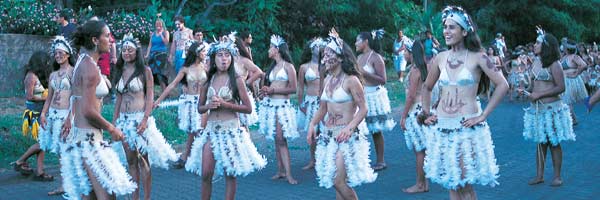
Easter Island's Tapati Festival is a mix of carnival type activities, sports events, canoe races, horse race, fishing tournament, theatrical presentations, handicraft, agricultural exhibitions, statue carving contest, shell necklace stringing competition, body painting contest and homage to the island, also known as Rapa Nui. Celebrated annually during summer, the festival covers several weeks at the end of January and into February. At this time, the island receives thousands of visitors who flood the hotels and other lodging places. Some islanders rent out their homes for the duration.
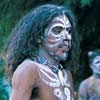
Dance competitions for all ages, parades with floats and costumed figures, and the crowning of the queen of the festival are highlights of the celebration. The festival activities expanded to include the celebration of Rapa Nui heritage with feasts, music, dance and fireworks.
Other festivals are, the "Takona" is a body painting competition, the paintings showed their social rank; the "Koro Haka Opo" is a singing contest between three groups, the group that repeats a song, loses the contest and "Riu" is a competition in which the most experienced members of each group interpret ritual chants that tell epic stories and legends from Rapa Nui.
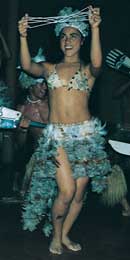
The music, dance and songs in Rapa Nui are fiercer and stronger. The presentations by the Rapa Nui Cultural Ballet are known as "Kari Kari".
Some of the the dances in the island are, "Hoko" lively dance that represents the activities of war. This is one of the most ancient artistic expressions. The "Hoko" dance has movements that imitate birds and humans. The dancers paint their bodies with different colours.
Other dance is the "Sau Sau", dance originally from Samoa, but adapted by the Rapa Nui. Men and women dance in pairs, but separately, with sensual movements of hips and shoulders. The dance is supposed to represent a flirtatious conversation in a boat, which moves with the waves. Women decorate their bodies with coloured feathers.
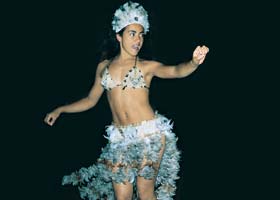
Typical clothings:
Ceremonial Tattoos
Tattooing was of great importance. It was done by experts under the supervision of the "Ariki Henua". A small bone punch with several very tiny comb like prongs on the end was dipped in black pigment made of burned "Ti" leaves and driven into the skin. It was a painful and lengthy process, repeated at various times during an individual's life.
Rapa Nui tattoo was comprised of fundamental motifs preserved and passed from one generation to the next.
Motifs included stripes, circles blocked in squares, triangles, interconnected hook forms and open square and points. The face was the focal area for the tattooist with the head being the most sacred "Tapu" part of the body. Tattoos were extended to the shoulders, upper back, buttocks and thighs with the designs on the arms having the least amount of detail. Tattoos on the back and lower body were predominantly broad areas of dots, crosshatching and panels of narrow vertical lines.
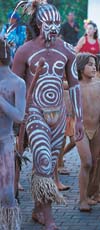
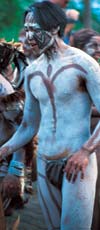
The tattoos have different meaning, it depends where they are in the body, and some are:
Gastronomy
Easter Island's gastronomy includes a wide range of sea food, the most important product is fresh lobster. Among the main dishes is included "Umu ta'o" or curanto, a preparation of fish, shellfish and vegetables that is wrapped in banana leaves before being slowly cooked in a hole in the ground covered with preheated volcanic rocks. It is served with a side helping of sweet potato "camotes" and "Po'e", a flour, banana and pumpkin pudding.
Another traditional dish is "Tunu ahi", fish cooked on red hot stones. Another recipe redolent of sea breeze is cebiche, which is made with fish or shellfish.
As man does not live on fish alone, Easter Island cuisine also includes meat dishes, such as pork or mutton ribs, a favourite food among the islanders, who accompany it with camote, mandioca, taro or uhi.
Another usual ingredient in islander diet is banana (plantain), because around 15 varieties of this fruit grow on the island. Generally it is served with the seafood.
In addition to the former dishes, the Rapa Nui menu also offers pizza and international cooking.

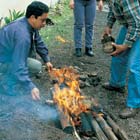
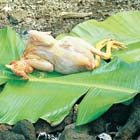
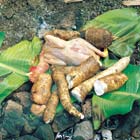
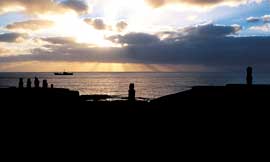
» The Importance of Dreaming Awake.
Camilo I. Cobo de la Maza, teacher of philosophy and cultural anthropologist, has carried out several research studies into the oral tradition of Rapa Nui’s culture. The island’s legends show how oneirism intervenes in the life of the islanders and becomes a means of connection to the Other World, where the spirits of their ancestors, relatives and gods live.
In concrete terms, Rapa Nui’s oneirism is verified by the existence of concrete archeological relics, described by the members of scientific expeditions to the island.
During the first half of the twentieth century, the island’s natives described their family traditions to Father Sebastián Englert, telling him that inside their homes they used “a smooth stone as a pillow.”
Then, in 1914, Katherine S. Routledge wrote “...inside the houses (in Orongo) we found stones that had been rounded and smoothened by the sea that they (the natives) use as pillows, and which were often engraved with rough images...”
As can be seen in Routledge’s text, these stone pillows were not only used for sleeping, but also as “dreaming stones” given that some of them bear inscriptions or images on the upper face that was in contact with the head. These engravings carried out specific instructions related to the dream the sleeper wished to experience.

» Tangata Manu or Bird Man.
In the middle of the eighteenth century, the ancestral social organization, which had developed in a close relationship between life, the spirits of nature and the gods, came to an end. Harsh tribal wars began. A delegation of wise men met in search of solutions and thus was born the cult of Tangata Manu, a new religion, a new political situation.
The old kings had lost their powers and were now only permitted to inaugurate the ceremonies of the coronation of the new Bird Man every spring. The candidates were those whose image was seen or whose voice was heard in dreams by one of the priests.
The god Make Make transmitted his power to the bird-man by giving him the “sacred egg” charged with mana. This egg belongs to a Manutara bird lay theirs eggs on Motu Nui, islet in front of the Rano Kau volcano. The eggs must be found by the Hopu manu, young men from each tribe, chosen and trained in all sports to obtain the divine grace for themselves and the political and military power for their chief for the period of one year.
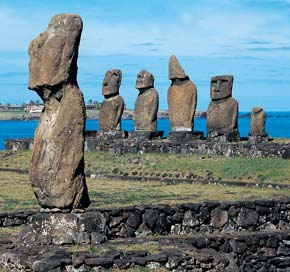
» Ahu Tahai y Vai Uri (ceremonial complex).
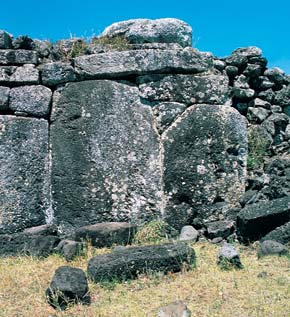
» Ahu Te Pito Kura.

» Ahu Huri A Hurenga.
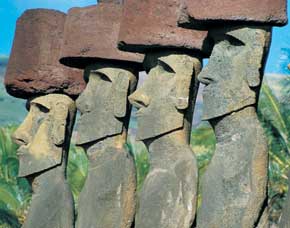
» Ahu Nau Nau with pukaos.
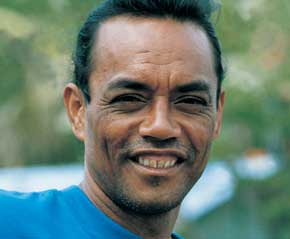
» Rapa Nui people.

» Rapa Nui people.
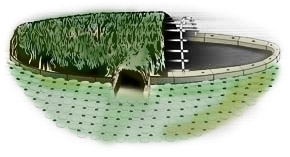
» House Boat illustration.
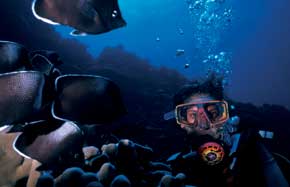
» Credits ORCA diving centers.
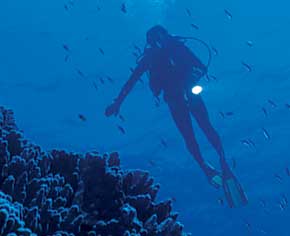
» Credits ORCA diving centers.

» Queen Elect.
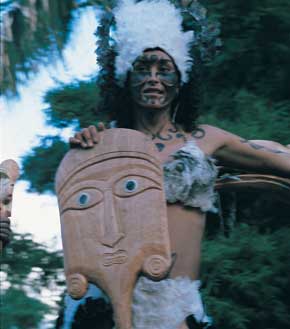
» Queen Candidate.

» Dancing.
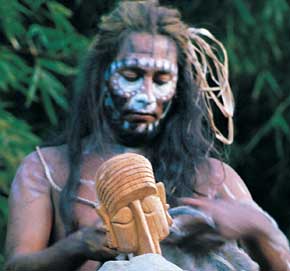
» Man with tattooed face.
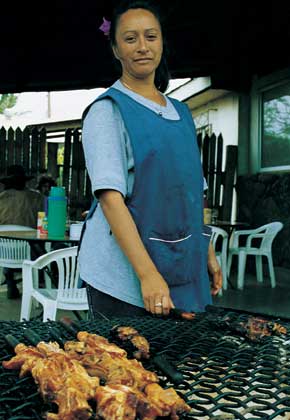
» Barbecue in front of the fair Hanga Roa.